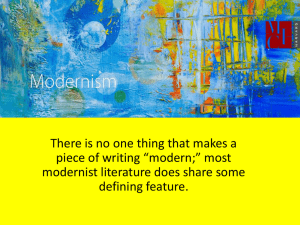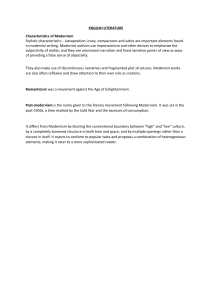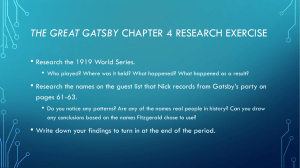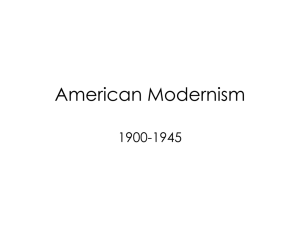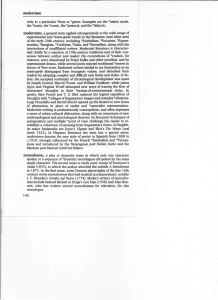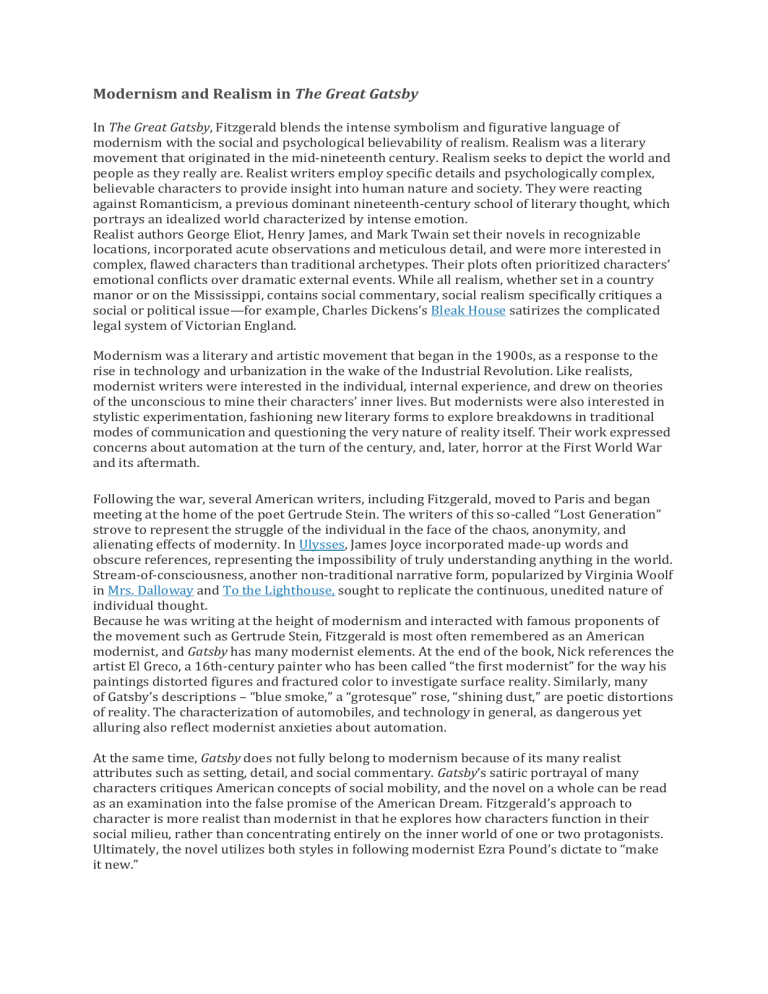
Modernism and Realism in The Great Gatsby In The Great Gatsby, Fitzgerald blends the intense symbolism and figurative language of modernism with the social and psychological believability of realism. Realism was a literary movement that originated in the mid-nineteenth century. Realism seeks to depict the world and people as they really are. Realist writers employ specific details and psychologically complex, believable characters to provide insight into human nature and society. They were reacting against Romanticism, a previous dominant nineteenth-century school of literary thought, which portrays an idealized world characterized by intense emotion. Realist authors George Eliot, Henry James, and Mark Twain set their novels in recognizable locations, incorporated acute observations and meticulous detail, and were more interested in complex, flawed characters than traditional archetypes. Their plots often prioritized characters’ emotional conflicts over dramatic external events. While all realism, whether set in a country manor or on the Mississippi, contains social commentary, social realism specifically critiques a social or political issue—for example, Charles Dickens’s Bleak House satirizes the complicated legal system of Victorian England. Modernism was a literary and artistic movement that began in the 1900s, as a response to the rise in technology and urbanization in the wake of the Industrial Revolution. Like realists, modernist writers were interested in the individual, internal experience, and drew on theories of the unconscious to mine their characters’ inner lives. But modernists were also interested in stylistic experimentation, fashioning new literary forms to explore breakdowns in traditional modes of communication and questioning the very nature of reality itself. Their work expressed concerns about automation at the turn of the century, and, later, horror at the First World War and its aftermath. Following the war, several American writers, including Fitzgerald, moved to Paris and began meeting at the home of the poet Gertrude Stein. The writers of this so-called “Lost Generation” strove to represent the struggle of the individual in the face of the chaos, anonymity, and alienating effects of modernity. In Ulysses, James Joyce incorporated made-up words and obscure references, representing the impossibility of truly understanding anything in the world. Stream-of-consciousness, another non-traditional narrative form, popularized by Virginia Woolf in Mrs. Dalloway and To the Lighthouse, sought to replicate the continuous, unedited nature of individual thought. Because he was writing at the height of modernism and interacted with famous proponents of the movement such as Gertrude Stein, Fitzgerald is most often remembered as an American modernist, and Gatsby has many modernist elements. At the end of the book, Nick references the artist El Greco, a 16th-century painter who has been called “the first modernist” for the way his paintings distorted figures and fractured color to investigate surface reality. Similarly, many of Gatsby’s descriptions – “blue smoke,” a “grotesque” rose, “shining dust,” are poetic distortions of reality. The characterization of automobiles, and technology in general, as dangerous yet alluring also reflect modernist anxieties about automation. At the same time, Gatsby does not fully belong to modernism because of its many realist attributes such as setting, detail, and social commentary. Gatsby’s satiric portrayal of many characters critiques American concepts of social mobility, and the novel on a whole can be read as an examination into the false promise of the American Dream. Fitzgerald’s approach to character is more realist than modernist in that he explores how characters function in their social milieu, rather than concentrating entirely on the inner world of one or two protagonists. Ultimately, the novel utilizes both styles in following modernist Ezra Pound’s dictate to “make it new.”
